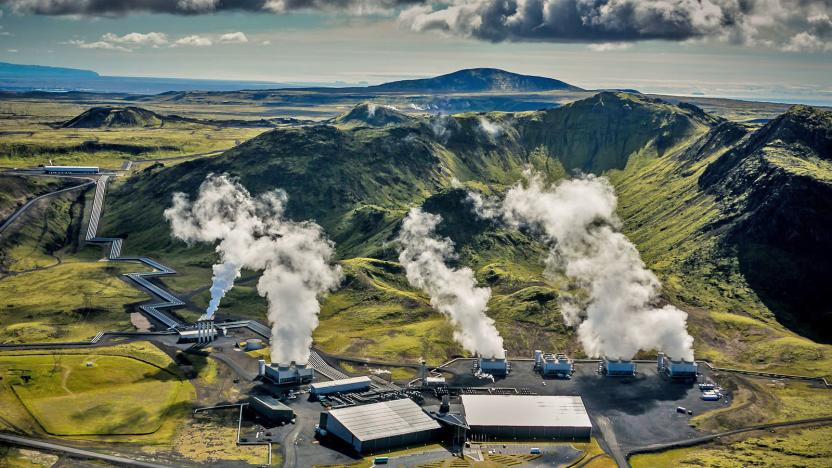geothermal
Latest

Google's first geothermal energy project is up and running
Google says a geothermal energy project that can produce clean electricity around the clock is up and running. The company aims to run its data centers and offices entirely on carbon-free energy by 2050.

How Dandelion is making geothermal heating affordable
Millions of US citizens still use oil and natural gas to heat their homes during the winter. Many would like to switch to geothermal, a cleaner and ultimately cheaper system that leverages the natural temperature of the earth. A few feet below the surface, the soil sits at a reliable 50- to 60-degree Fahrenheit all year round. Pipes known as 'ground loops' push round a special antifreeze solution that absorbs this constant temperature in winter and disperses unwanted warmth in the summer. A large indoor heat pump uses the mixture to boil a refrigerant fluid; the resulting gas is then compressed to higher temperatures and distributed around the home. Installing the necessary equipment is expensive, however. Dandelion, a company that started inside Alphabet's X division, is trying to make geothermal cheaper and easier to install. While not the most eye-catching technology, especially compared to electric cars and sea-cooled data centers, it's arguably one of the most important for the environment.

First-ever 'negative emissions' power plant goes online
Unfortunately, it's no longer enough to cut CO2 emissions to avoid further global temperature increases. We need to remove some of the CO2 that's already there. Thankfully, that reversal is one step closer to becoming reality. Climeworks and Reykjavik Energy have started running the first power plant confirmed to produce "negative emissions" -- that is, it's removing more CO2 than it puts out. The geothermal station in Hellsheidi, Iceland is using a Climeworks module and the plant's own heat to snatch CO2 directly from the air via filters, bind it to water and send it underground where it will mineralize into harmless carbonates.

A city covered in trees will fight air pollution in China
It's easy to find buildings laced with greenery in order to reduce their CO2 footprints. But what about an entire city? That's on its way. Construction has started on Liuzhou Forest City, a 30,000-person urban development where every building will be covered in pollution-reducing plants (over 1 million of them, in fact). They'll also rely on geothermal energy for air conditioning and pack solar panels to collect their own energy. Logically, the transportation network will be green as well. It'll revolve around electric cars and a central rail line that links the experimental space to the city of Liuzhou.

First solar-geo plant blooms in Nevada's high desert
Drive west on US Route 50 through a stretch of Nevada highway known as "The Loneliest Road in America" and you'll eventually find yourself in the rural county of Churchill. Once a solitary leg in the Pony Express route, irrigation transformed swaths of Churchill's high desert areas into thriving agricultural communities more than a century ago. Fast forward to today and Churchill finds itself playing host to yet another interesting dichotomy -- a first-of-its-kind power plant that generates electricity by harvesting renewable resources from both earth and sky. %Gallery-159924%

Inhabitat's Week in Green: ice castles, cardboard columns, and the Geneva Auto Show
Each week our friends at Inhabitat recap the week's most interesting green developments and clean tech news for us -- it's the Week in Green. This week Inhabitat showcased several jaw-dropping feats of architecture, starting with a series of amazingly complex computer-designed cardboard columns that boast between 8 and 16 million facets. We were also struck by a stunning new net-zero Solar Academy in Germany, and we showcased a Swiss chalet that is the world's first apartment building to be heated entirely by solar thermal energy. On the cooler end of the climate spectrum, a Minnesota man has created a series of soaring ice castles using water from his geothermal heating system. The Geneva Auto Show also kicked off with a bang this week as Koenigsegg unveiled its supercharged Agera R racer and SAAB rose from the ashes with a futuristic PhoeniX hybrid. We also heard big news from some of the world's most luxurious automakers as Bentley rolled out a biofuel-powered supercar that can go 200 MPH on ice and Rolls-Royce unveiled their all-electric 102 EX Phantom. Two-wheeled transportation also took a leap forward as Daymak unveiled the world's first wireless electric eBike and Los Angeles approved plans for 1,690 miles of bikeways. We also kept on the cutting edge of consumer tech with a look at the green credentials of Apple's iPad 2, and we brought you researchers' plans for a hot new breed of batteries made from "frozen smoke". Finally, we learned from a recent study that cellphone signals actually boost brain activity, and we shared a fresh new line of iPod nano watch straps just in time for spring.

Inhabitat's Week in Green: SunPower supplants Ford, lava power, and the airlifted eco shelter
Each week our friends at Inhabitat recap the week's most interesting green developments and clean tech news for us -- it's the Week in Green. This week Inhabitat saw geothermal power projects pick up steam around the world as Iceland eyed liquid magma as an energy source and the UK sought to tap geothermal reserves under Newcastle. We also saw scientists develop a stretchable solar-powered sensor that can detect the drop of a pin, and we were impressed by a brilliant system that uses algae to treat wastewater and generate fuel in one fell swoop. We also showcased several innovative examples of high-tech architecture - Wales' futuristic newport transit station and a massive green-roofed innovation hub that is set to become Botswana's first LEED-certified building. Solar-powered structures were a hot topic as well as we took a look inside SunPower's incredible renovated headquarters, learned about the new location of the 2011 Solar Decathlon, and showcased a photovoltaic-powered alpine eco shelter. Finally, this week we got set for the start of spring by sharing our five favorite green gadget gardening tools and a rainwater recycling system that comes complete with a solar pump. We also spotted a chic cradle-to-cradle raincoat that will fend off impending showers and a natty wool iPad cover that will keep your tablet cozy in blustery weather.

Inhabitat's Week in Green: the world's largest laser fired, icy roof tiles admired, faucet lamps inspired
Each week our friends at Inhabitat recap the week's most interesting green developments and clean tech news for us -- it's the Week in Green. This week scientists took a step towards unlocking the holy grail of alternative energy as they unleashed a one megajoule test blast from the world's largest laser. We were also excited to see the DOI give the green light for the first solar-thermal power tower in the United States, and we saw big things brewing beneath West Virginia as a project funded by Google discovered massive geothermal vents that could double the state's energy generation capacity. Not to be outdone, Oregon announced plans for a 845 megawatt wind farm that stands to be the largest in the world. We also watched the world of architecture heat up - literally - as Soltech unveiled a set of glimmering glass roof tiles that can capture solar energy to heat your home. We also checked in on the development of Masdar, the world's first carbon neutral zero-waste city, and we were shocked and appalled by the recently completed largest and most expensive house in the world. In other news, this week we showcased a dazzling array of energy-efficient lights - from an amazing animated LED pillar to a set of liquid lights made from recycled faucets to a chandelier decked out with luminous dandelions. We also kicked up our heels for a vending machine that dispenses biodegradable shoes and we saw a set of ghetto-fabulous boom boxes made from old suitcases hit the streets. Finally, we rounded up a gaggle of our favorite smartphone games that are perfect for keeping kids entertained!

Inhabitat's Week in Green: solar houses, geothermal power, and the world's slowest Porsche
The Week in Green is a new item from our friends at Inhabitat, recapping the week's most interesting green developments and clean tech news for us. This week Inhabitat showcased some of the world's most stunning sun-powered homes as the European Solar Decathlon kicked off Friday in Madrid, Spain. We can't wait to see the winner of this year's competition, which challenged 17 teams from around the world to build the most efficient solar-powered house. Will it be the University of Nottingham's hyper-efficient H.O.U.S.E, Florida's Re:Focus prefab, or one of the other amazing contenders? Speaking of solar power, the field of clean tech had a hot week as Sanyo unveiled the world's most efficient solar module. We also saw solar power energize Africa's largest slum as a photovoltaic television set allowed residents of Kibera, Nairobe to watch the World Cup. Several massive new geothermal projects rounded out our renewable energy news this week as the US Department of Energy unveiled plans to make Nevada the "Saudi Arabia of Geothermal Energy". In other news, two-wheeled transportation took the world by storm as Italy unveiled its first electric motorcycle and Switzerland showcased its Zerotracer Superbike, which is set to circle the globe in 80 days using only renewable energy. And if a peddle-powered ride is more your pace, then you won't want to miss the world's slowest Porsche. If all that exciting transportation news has you overheating, then relax and cool off -- here's a futuristic refrigerator that keeps things cool with bio gel and an underarm clothing patch that eliminates body odor through nanotechnology. And finally, if you're ready to relax and slip into some summer reading, we're giving away an iPad complete with a bamboo DODOcase -- hit the link to enter!

Inhabitat's Week in Green: wind power, shoe power, and the world's largest laser
The Week in Green is a new item from our friends at Inhabitat, recapping the week's most interesting green developments and clean tech news for us. This week Inhabitat showcased several smart new technologies that harness clean green energy from unexpected (and undeniably awesome) sources. Volcanoes may be the bane of air travel as of late, but Indonesia has hatched a plan to harness their geothermal might to produce 4,000 megawatts of power. Meanwhile The Netherlands is turning the tide on hydroelectric power by upgrading their dikes with energy generating underwater turbines. In other news, harnessing energy from stars may seem like an out-of-this-world proposition, but that's precisely what scientists are attempting to achieve as they fire up the world's largest laser in an attempt to grasp the holy grail of energy: nuclear fusion. And speaking of out-of-this-world developments, this week Japan announced plans to launch its solar "Ikaros" spacecraft, which will sail through the stars using rays of light. While keeping stride with these developments we also looked at several innovative technologies that stand to shape the future of consumer tech. Looking to put some punch in your step? Then try these energy generating piezoelectric shoes on for size. We also brought an eye-opening new night vision technology to light that is so thin, lightweight, and cheap that it can integrated directly into eyeglasses, car windows, and cell phone cameras. Even our canine friends are getting high-tech upgrades -- check out this geo-tagging rescue dog jacket that can be used by people in peril to transmit emergency messages. Finally, this weekend marks the start of the 2010 Shanghai World Expo, which we're celebrating by showcasing the top six futuristic pavilions that harness high-tech green building strategies. But if you only check out one, make it the amazing interactive Dream Cube, which is made from recycled CD cases and features a stunning LED-laden facade that changes color with a wave of the hand.



